- Products
- PoE Media Converters and Switches
- Ethernet & PoE Switches Product Selector
- Multi-Gigabit Ethernet and PoE Switches
- PoE PSE Commercial Switches
- PoE PSE Industrial Fiber Switches
- PoE Industrial Copper Extenders
- PoE Powered Media Converters
- PoE PSE Media Converters
- PoE Extenders & Injectors Product Selector
- Pluggable Transceivers Product Selector
- Single Pair PoE Products
- Product Lines
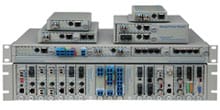
- iConverter Managed Multi-service Platform
- Copper to Fiber Media Converters
- Ethernet Media Converters
- 10 Gigabit Copper-to-Fiber
- 10/100/1000 Copper to 10 Gigabit Fiber
- 10/100/1000 Copper-to-Fiber with Integrated Management
- 10/100/1000 Industrial Copper-to-Fiber with Integrated Management
- 10/100/1000 Copper-to-Fiber with VLAN
- 10/100/1000 Dual Media Converter with VLAN
- Gigabit Copper-to-Fiber
- 10/100 Copper-to-Fiber with Integrated Management
- 10/100 Industrial Copper-to-Fiber with Integrated Management
- 10/100 Copper-to-Fiber with VLAN
- 10/100 Copper-to-Fiber
- Fast Ethernet Copper-to-Fiber
- Fast Ethernet Redundant Links
- 10Mbps Copper-to-Fiber
- 10Mbps Copper to Coax
- TDM Media Converters
- Serial Media Converters
- Ethernet Media Converters
- Fiber to Fiber Media Converters
- 10 Gigabit Fiber-to-Fiber Converter and Transponder
- 10 Gigabit Industrial Converter and Transponder
- SFP-to-SFP Fiber Converter and Transponder
- SFP-to-SFP Industrial Fiber Converter and Transponder
- Gigabit Fiber to-Fiber with 3 Rs
- 100/1000 Fiber-to-Fiber with 3 Rs
- Gigabit Fiber-to-Fiber
- Fast Ethernet Fiber-to-Fiber with 3 Rs
- Fast Ethernet Fiber-to-Fiber
- OC-3/STM-1 Fiber-to-Fiber
- OC-12/STM-4 Fiber-to-Fiber
- Carrier Ethernet Network Interface Devices
- CE 2.0 - 10G Demarcation NID
- CE 2.0 - 10/100/1000 Mult-port NID
- CE 2.0 - 10/100/1000 Mult-port NID with PoE
- CE 2.0 - 10/100/1000 8-Port NID
- CE 1.0 Service OAM - 10/100/1000 NID
- CE 1.0 Link OAM - 10/100/1000 Copper-to-Fiber NID
- CE 1.0 Link OAM - 10/100 Copper-to-Fiber NID
- CE 1.0 Link OAM - Gigabit Fiber-to-Fiber NID
- CE 1.0 Link OAM - Fast Ethernet Fiber-to-Fiber NID
- CWDM Multiplexers
- T1/E1 Multiplexers
- Ethernet Switch Modules
- Management System
- Chassis Options

- 1-Module Industrial Chassis

- RuggedNet Industrial Switches and Extenders
- Industrial PoE PSE Fiber Switches
- Multi-Gigabit Managed Industrial PoE+/BT Switches
- Multi-Gigabit Unmanaged Industrial PoE+/BT Switches
- 10G Managed 802.3bt PoE Switches
- 10G Unmanaged 802.3bt PoE Switches
- 10G Managed PoE+ Switches
- 10G Unmanaged PoE+ Switches
- 1G Managed PoE+ Switches
- 1G Unmanaged PoE+ Switches
- 1G Unmanaged 802.3bt PoE Switches
- 1G Managed 802.3bt PoE Switches
- Industrial SPE Switches
- Industrial Ethernet Switches
- Industrial PoE Copper Extenders
- Industrial Power Supplies

- OmniConverter Media Converter, Switches and Extenders
- PoE PSE Media Converters
- 10G Multi-Gigabit / Multi-Rate PoE Media Converter
- 10G Multi-Gigabit / Multi-Rate Media Converter
- 10/100 Multi-port PoE+ Media Converter
- 10/100 PoE+ Media Converter
- 10/100/1000 Multi-Port PoE+ Media Converter
- Industrial 10/100/1000 Multi-Port PoE+ Media Converter
- 10/100/1000 PoE+ Media Converter
- 10/100/1000 PoE++ 60W-100W Media Converter
- Industrial 10/100 Multi-port PoE+ Media Converter
- 1U Rack-Mount Shelf
- PoE PSE Compact Switches
- Multi-Gigabit Managed PoE+/BT Switches
- Multi-Gigabit Unmanaged PoE+/BT Switches
- 10G Managed 802.3bt PoE Switches
- 10G Unmanaged 802.3bt PoE Switches
- 10G Managed PoE+ Switches
- 10G Unmanaged PoE+ Switches
- 1G Managed PoE+ Switches
- 1G Unmanaged PoE+ Switches
- 1G Managed 802.3bt PoE Switches
- 1G Unmanaged 802.3bt PoE Switches
- Ethernet Switches
- Single Pair Ethernet (SPE)
- PoE Copper Extenders
- PoE Injectors
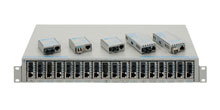
- miConverter Unmanaged Miniature Media Converters
- 10/100/1000 Copper-to-Fiber
- Industrial 10/100/1000 Copper-to-Fiber
- 10/100/1000 Ultra-Compact Copper-to-Fiber
- Gigabit Copper-to-Fiber
- 10/100/1000 Copper-to-Fiber PoE Powered
- 10/100 Copper-to-Fiber
- 10/100 Ultra-Compact Copper-to-Fiber
- 10/100 Copper-to-Fiber PoE Powered
- 18-Module Chassis
- Industrial 10/100 Copper-to-Fiber PoE Powered

- FlexSwitch Compact Switches
- Solutions
- Company
- Support
- How to Buy
Everything you need to know about Multi-Gig Ethernet
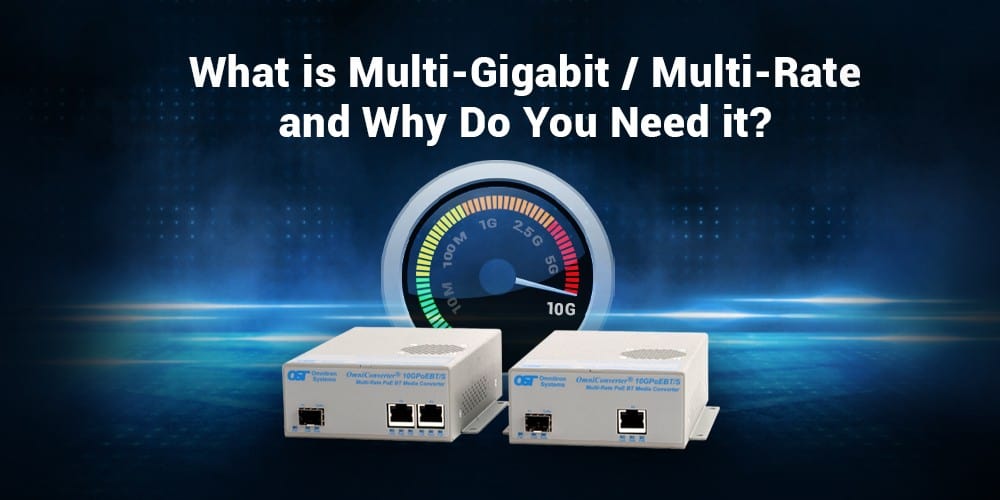
Multi-gigabit Ethernet provides higher bandwidth than the 1Gb data rates utilizing the existing cable infrastructure preventing expensive infrastructure upgrades. Multi-gigabit Ethernet has five different data rates: 100Mbps, 1Gbps, 2.5Gbps, 5Gbps and 10Gbps (up to 5Gbps is supported in Cat5e cables). This blog reviews what Multi-Gigabit Ethernet is and presents common applications for Multi-Gigabit connectivity.
From the 10 Mbps Ethernet released in1980 by the DEC-Intel-Xerox consortium, the speed of Ethernet has increased due to the rising bandwidth demands. Following the development of narrow coaxial Ethernet, various models such as twisted pair cable and fiber optic cable were developed for 10 Mbps systems. Fast Ethernet, Gigabit Ethernet and now Multi-gigabit Ethernet evolved through several stages.
IEEE introduced Fast Ethernet in 1995 under the 802.3u standard, with a transmission speed of 100 Mbps. IEEE introduced Gigabit Ethernet in 1999, and it has a transmission speed of 1000 Mbps (or 1Gbps).
Multi-gigabit Ethernet aka Multi-rate Ethernet was released in the form of the IEEE802.3bz standard in 2016. The multi-gigabit Ethernet has five different data rates: 100Mbps, 1Gbps, 2.5Gbps, 5Gbps and 10Gbps (up to 5Gbps is supported in Cat5e cables). Multi-gigabit Ethernet provides higher bandwidth than the 1Gb data rates utilizing the existing cable infrastructure preventing expensive infrastructure upgrades. Multi-gig Ethernet is compatible with Cat5e cabling infrastructure and above, network speeds up to 5Gbps can be achieved at maximum lengths (100m) with Cat5e/Cat6 cables and up to 10Gbps at maximum lengths (100m) with Cat6a cable.
Multi-gigabit Ethernet connects modern, high-performance, bandwidth demanding network devices such as small cells, IoT (Internet of Things) devices, surveillance cameras and Wi-Fi 6/6E Access Points that require greater than 1Gb and up to 10Gbps of bandwidth.
Do you need Multi-Gig connections?
The network infrastructure must adapt to a combination of legacy and modern device types and applications that require high bandwidth and power, such as connecting to the latest Wi-Fi 6/6EAccess Points, Small Cells and IP surveillance cameras. If you want the fastest Ethernet connection and the ability to add new devices with high bandwidth to the network that require a data rate of more than 1Gbps and have to be backward compatible, then you need Multi-Gig connections.
Why multi-gigabit Ethernet is required in 2023
Multi-gigabit Ethernet is needed in 2023 because of modern and high performance network devices with higher bandwidth that are being developed requiring the need for mulit-gigabit networking equipment. Therefore, the network infrastructure must be upgraded to support the growing demands of IoT (Internet of Things) devices, small cell devices and Wi-Fi access devices.
Omnitron Multi-Gigabit / Multi-Rate Media Converters
Omnitron has purposely designed four classes of multi-gigabit aka multi-rate media converters with models that function as PoE injectors. The Omnitron Multi-Gigabit / Multi-Rate Media Converters follow market demand for high PoE power and multi-gigabit/multi-rate high bandwidth for the latest Wi-Fi 6/6E access points. These new multi-gigabit / multi-rate media converters support multi-rate speeds of 10Mbps, 100Mbps, 1Gbps, 2.5Gbps, 5Gbps, and 10Gbps.
Multi-Gigabit Media Converter
The Multi-Gigabit/Multi-Rate media converter features up to two multi-gigabit/multi-rate RJ-45 access/user ports and one 1/10G SFP/SFP+ (Small Form Pluggable) uplink port that supports various pluggable fiber transceivers.
The multi-gigabit/multi-rate RJ-45 access/user ports support multi-gigabit/multi-rate speeds of 10Mbps, 100Mbps, 1Gbps, 2.5Gbps, 5Gbps and 10Gbps. The 1/10G SFP/SFP+ uplink port supports 10/100/1000BASE-T, 1000BASE-T, 2.5BASE-T, 5GBASE-T and 10GBASE-T copper transceivers and 1G and 10G multimode or single-mode fiber, dual or single-fiber transceivers in standard, CWDM and DWDM wavelengths.
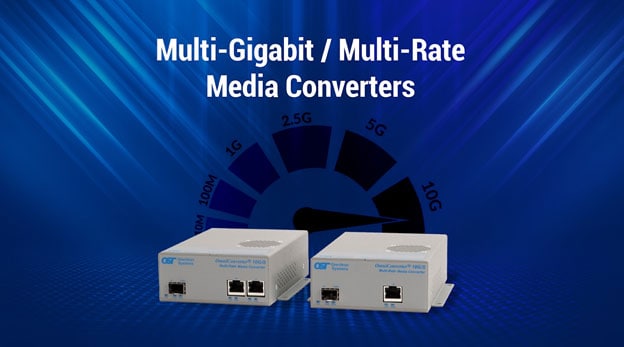
Omnitron Multi-Gigabit Media Converter Benefits
The Multi-Gigabit and Multi-Rate media converters are backward compatible, can be connected to the existing cable infrastructure boosting speed and performance saving CAPEX and OPEX.
- Six different Ethernet data rates
- Auto-negotiate to find ideal data rate for the devices
- Backward compatible
- Use existing cabling infrastructure with no forklifts
- Supports PoE (Power over Ethernet) up to 100W for PoE Powered devices (PDs)
- CAPEX and OPEX saving
Multi-Gigabit Ethernet Applications
Multi-gigabit Ethernet can be used in many different networking applications. Below are several applications for multi-gigabit/multi-rate media converters and PoE media converters.
Omnitron Multi-Gigabit Media Converter Application
In this application, each multi-gigabit/multi-rate media converter is located near an AC power source and connects to a 10G fiber switch. The multi-gigabit media converters provide high-speed connectivity to small cell devices that require up to 10Gbps of bandwidth, IP surveillance cameras and Wi-Fi 6/6E Access Points.
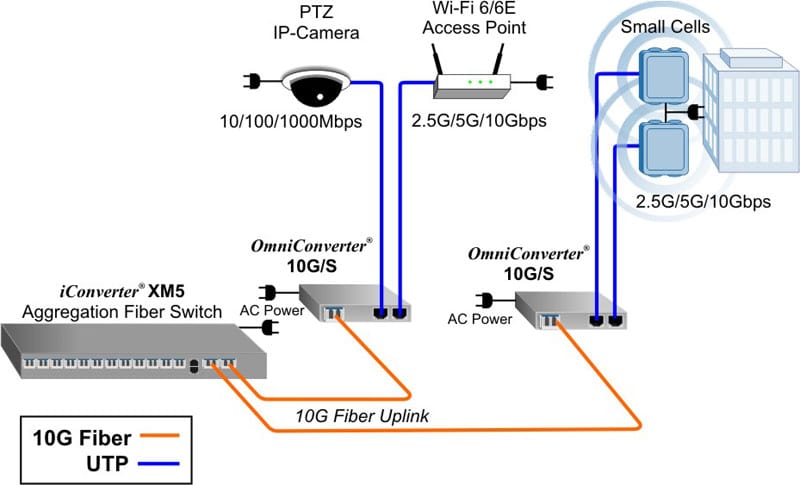
Omnitron Multi-Gigabit PoE Media Converter Application
In each PoE application below, the Multi-Gigabit/Multi-Rate PoE media converter is installed up to 100m away from the PoE Powered Device (PD) and connects over a UTP cable to supply power.
- Security and Wireless
In this application, outdoor IP surveillance cameras and Wi-Fi 6/6E Access Points are installed throughout a large facility. A 10G fiber switch is used to distribute a fiber link from a control room to multi-gigabit/multi-rate PoE media converters with fiber ports.
The multi-gigabit/multi-rate media converters provide up to 100W of Power-over-Ethernet (PoE) to an IP camera and Wireless Access Point at each location, which is located up to 100 meters from the media converter. The camera and access point have full bandwidth capability and use the 10G fiber uplink port on each multi-gigabit and multi-rate PoE media converter.
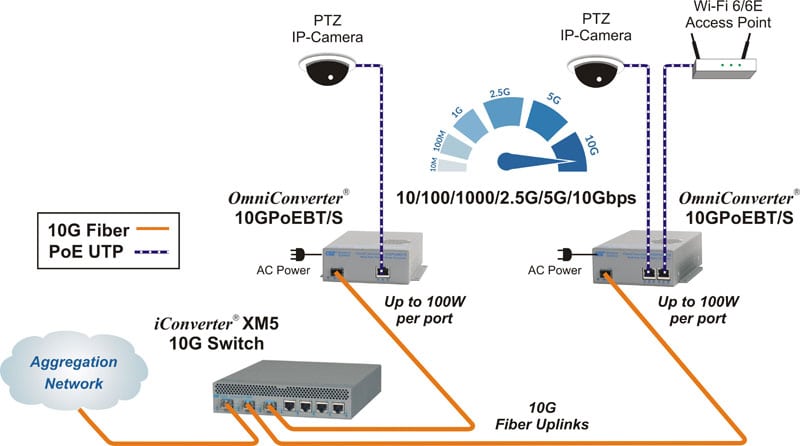
- Small Cell
5G Small cell devices are increasing their demand for both power and bandwidth requirements. Speeds of 10Gbps and power of 100W are common with today’s small-cell devices.
In this application, high-speed small cell devices that require up to 10Gbps bandwidth are installed inside several buildings. A fiber switch is used to distribute a fiber link to each multi-gigabit and multi-rate media converter, which provides up to 100 watts and speeds up to 10Gbps on the RJ-45 user ports.
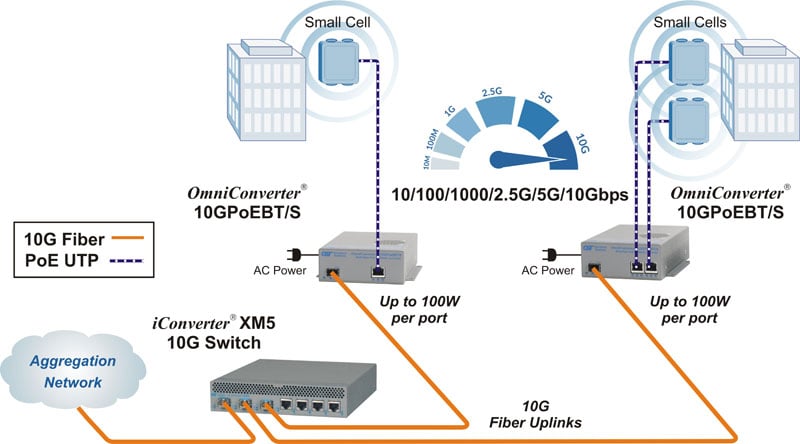
Conclusion
If you need to add modern and high performance network devices or upgrade your network, consider using Omnitron multi-gigabit PoE media converters. They will allow you to connect older equipment without having to do any complicated wiring and can provide power over Ethernet for new devices that need it. All OmniConverter® 10G Multi-Gigabit aka Multi-rate Media Converters are designed and manufactured in the USA, comply with TAA and NDAA, feature a lifetime warranty and come with free 24/7 technical support.
If you have any future questions about Multi-Gig or if you are still unsure about which of the products is best suited to your network, contact Omnitron Systems technicians to get pre-sale support. We are available 24 hours a day, seven days a week, 365 days a year, to answer your questions.
References:
https://www.versitron.com/blog/fast-ethernet-vs-gigabit-ethernet-differences
https://www.belfuse.com/home/resources/technical-library/how-multi-rate-ethernet-enables-higher-speeds-at-lower-cost
https://www.arubanetworks.com/faq/what-is-multi-gigabit-ethernet/
https://www.tp-link.com/us/blog/734/multi-gig-ethernet-what-is-it-and-how-to-set-it-up-at-home/
https://www.extremenetworks.com/extreme-networks-blog/is-multi-rate-right-for-you-webinar-blog/









